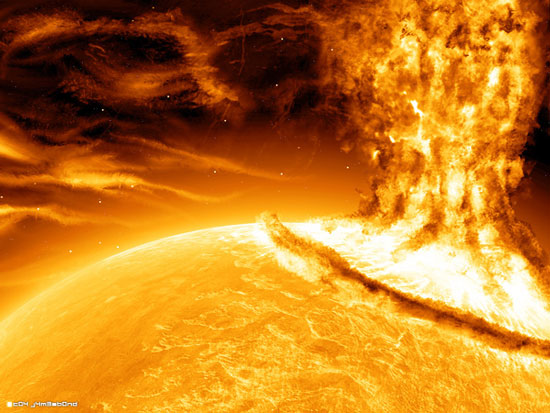Things to know about solar storms
Solar storms are intense events that occur on the sun when electrons, atoms, and ions are released into space. They can be combined with mass eruptions of the sun (CME phenomenon) or magnetic storms, moving through space.
>>> Solar storms are more devastating for decades to come
This radiation explosion can be directed to Earth, taking a few days to reach our planet, which can significantly hinder our telecommunications infrastructure, depending on the size of our planet. it.
Strong flames can damage satellites, electrical systems, and jamming radar systems, causing trouble-free road traffic.
This is why NASA scientists keep a close eye on the sun using the spacecraft fleet.

The National Oceanic and Atmospheric Administration (NOAA) and other agencies can minimize damage by observing the space weather to predict storms, for example by placing satellites in safety'.
Every 11 years is a solar cycle, during which time the sun's magnetic activity levels fluctuate. Each cycle reaches the maximum point when the solar storm becomes more frequent and stronger, increasing the likelihood of a large fire appearing to affect the Earth.
During this time, the sun may appear dark spots, which are areas of intense magnetic activity and are often associated with flames.
Solar storms are classified according to their levels: B, C, M, and X. The level is 10 times stronger than the previous level. Each level is divided into 1-9 levels.
X-type flames are capable of causing power outages around the world and global transmission problems, and can reach magnitude above level 9, for example, a large X-type fire beam in 2003 is estimated to be X- 45.
Solar storms are not only in the sun, they also occur in other stars and are called stellar storms.
- Dozens of strong storms and storms can pour into Vietnam
- Solar storm attacks the earth
- Typhoon is equivalent to one million tons of explosives causing Mars to be dry
- The Sun Storm caused many animals to get lost?
- Solar storms are stronger in the next 11 years
- Solar storms are impervious to earthquakes
- New technique to monitor solar storms
- Solar Storm is about to reach Earth in the near future: the risk of attacking the electrical and satellite systems
- Ancient texts help forecast ... the solar storm
- A strong solar storm occurred
- What is solar storm?
- Discover the mechanism of solar storms near Earth
 Van Allen's belt and evidence that the Apollo 11 mission to the Moon was myth
Van Allen's belt and evidence that the Apollo 11 mission to the Moon was myth The levels of civilization in the universe (Kardashev scale)
The levels of civilization in the universe (Kardashev scale) Today Mars, the sun and the Earth are aligned
Today Mars, the sun and the Earth are aligned The Amazon owner announced a secret plan to build a space base for thousands of people
The Amazon owner announced a secret plan to build a space base for thousands of people